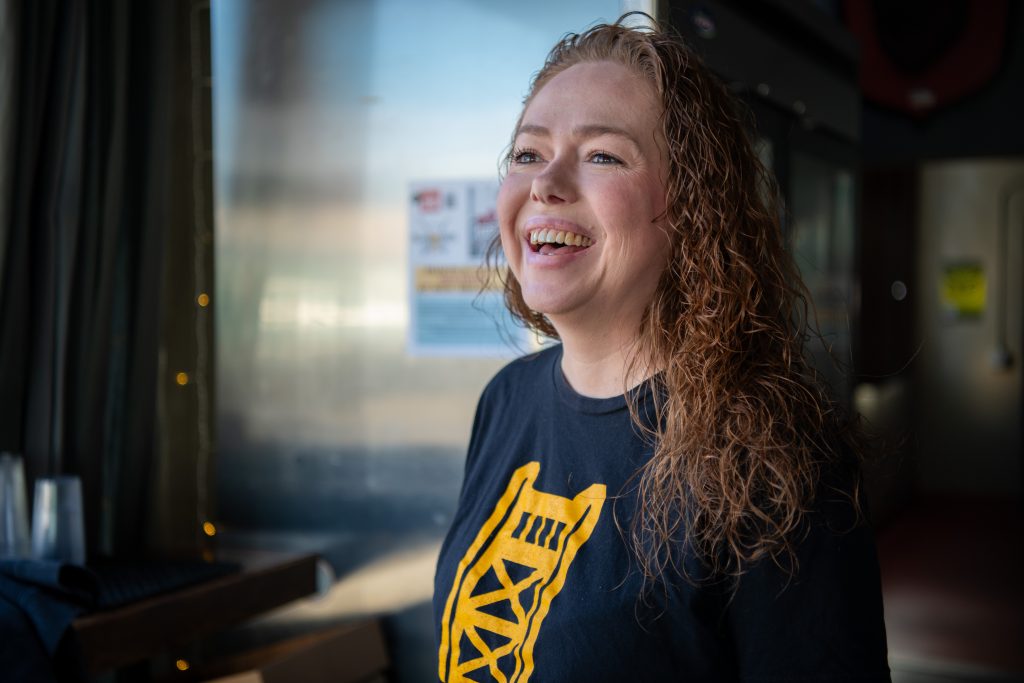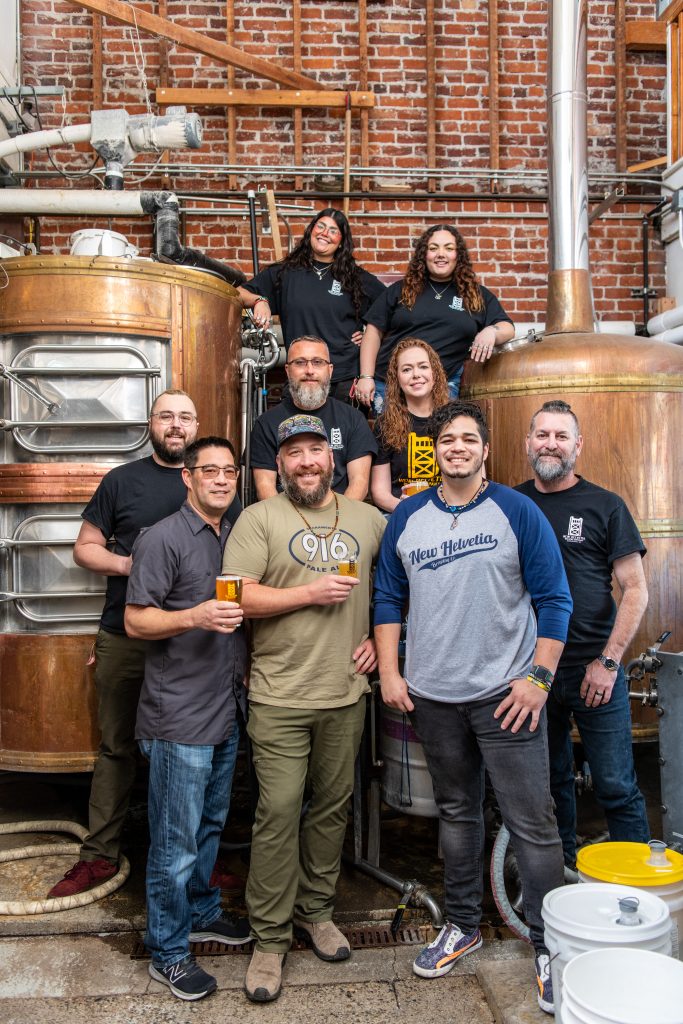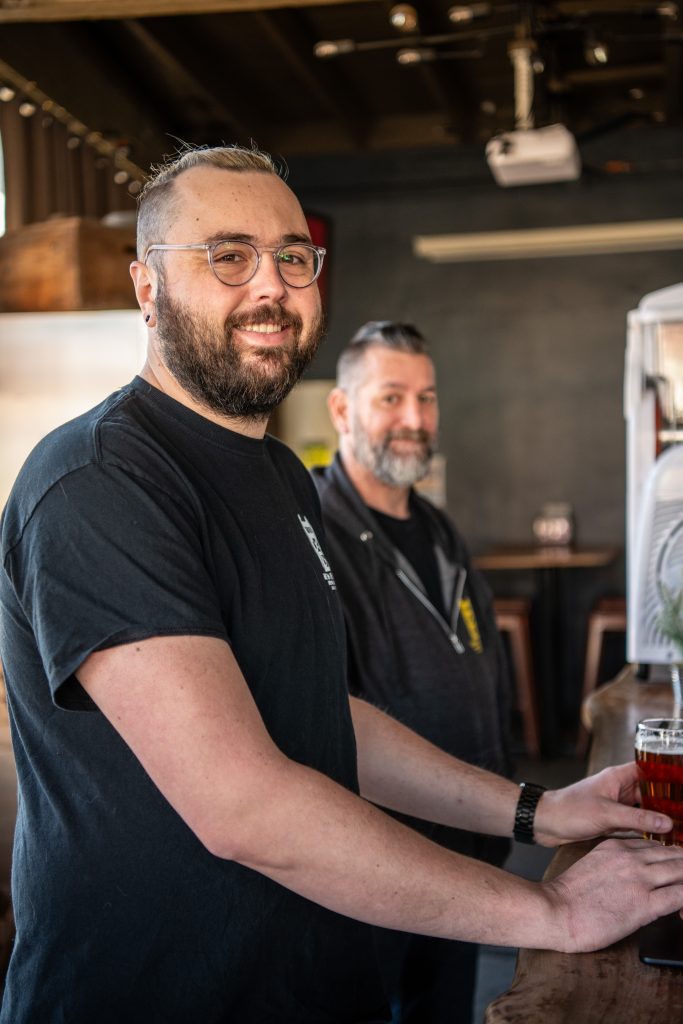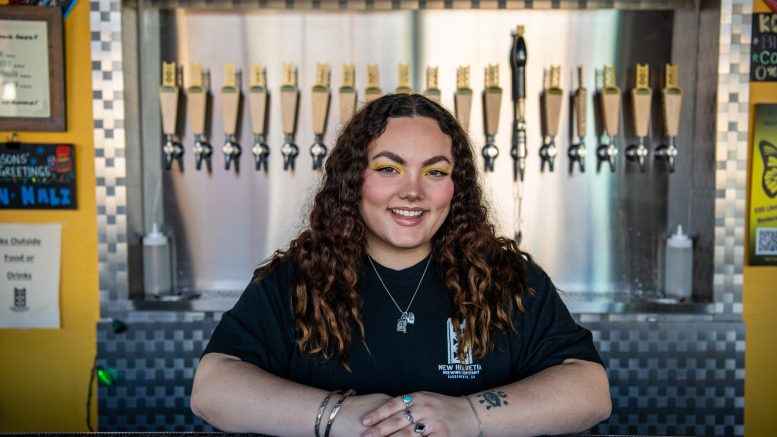By Russell Nichols
In 2012, a land surveyor wandered into the new brewery off Broadway looking for a drink, but he was drawn to a map.
It was hanging at New Helvetia Brewing Company. Nick Labedzki, who makes maps for the state of California, admired John Sutter’s sepia-tinged 1839 land grant from the Mexican government, a relic from when the area now called Sacramento was part of a 48,000-acre rancho called New Helvetia (“Nueva Helvecia Colonia”), the brewery’s namesake.
Celebrating Sacramento’s history while investing in its future is what the brewery was built on. “For us, supporting local is a matter of pride,” its website says. And for the past decade, Labedzki has been dropping by New Helvetia about once a week to proudly support locally sourced craft beers. He likes their ThunderBeast and It’s Always Hazy In Sacramento IPAs. But more than that, he likes the community, all the people who know him.
“I want to be like Norm from ‘Cheers,’” he says.
Norm Peterson, the loyal wise-cracking patron on the 1980s sitcom, once remarked: “It’s a dog-eat-dog world, Sammy, and I’m wearing Milk-Bone underwear.” For many small businesses, including New Helvetia Brewing Company, that sentiment felt all too familiar in the aftermath of the pandemic. In August, the 11-year-old community brewery, mauled by escalating costs and diminishing revenues, posted a message on Instagram about its struggle to keep up with rent payments and the real prospect of eviction and closure.
“While this may cast doubts on our future at 18th and Broadway, we remain firm in our belief that New Helvetia can overcome these adversities,” the post reads.
Three months later, New Helvetia Brewing Company announced a transformational shift from a traditional brewery model to a community and employee-owned cooperative. For a $300 lifetime membership fee, individuals become “member-owners,” who vote in major decisions, elect officers and board members, and can adopt or amend bylaws. With the support of customers and community members, New Helvetia Brewing Cooperative is now redesigning its own business map to navigate the obstacles in the craft beer market and hospitality industry.
“It’s a small community-based brewery and you hate to see mom-and-pop businesses go under through no fault of their own,” says Labedzki, who has already filled out his application to be a member-owner. “This isn’t like a Sierra Nevada Brewing Company or Budweiser or whatever. This is a small-town brewery and you don’t want to see these things go away. I don’t.”
Uncharted Territory

New Helvetia Brewing Cooperative will work like the Sacramento Natural Foods Co-op or REI. But those businesses started as co-ops. A full-on conversion from established business to cooperative ownership structure, which requires a lot of planning and resources, is rare.
The brewery currently employs 12 people. The Workers Assembly, composed of employees, will handle day-to-day decisions. Major fiscal choices will be put to a full membership vote, but the wages for employees will be set by the co-op. Of course, being a member-owner also comes with perks, which may include 20% discounts on pints and food in the Tap Room, 10-25% off merchandise, and four-pack purchases based on beer styles. But the key here is ownership, says David Gull, founder of New Helvetia Brewing Company.
As a fourth-generation resident of Sacramento, Gull opened New Helvetia in 2012 to revive the legacy of the historic Buffalo Brewing Company. By 2016, Gull says, New Helvetia had reached 1,200 barrels of annual production, self-distributing from the Bay Area to Tahoe and Redding to Fresno. The financial hit from the pandemic forced the brewery to weigh four options: continue the status quo and eventually fail; close outright and lose everything; sell to another buyer, but the prospects of that are slim; pursue a non-traditional solution of forming a worker and community co-op. As far as Gull knows, this conversion to a brewery co-op has never been done before.
“As the founder of the original [brewery business], I’m of course very supportive,” he says. “It will clearly benefit us to transition into a co-op and move assets over, pay down debts on our side, engage the community to ensure it continues into the future. … What will be my new role? I have to see if my employees hire me. They are now in charge.”
Change A-brewing

This past July, after 127 years in business, San Francisco’s iconic Anchor Brewing Company, hailed as “America’s First Craft Brewery,” closed down. Anchor staff — production workers, managers, bartenders and others — decided they were the ones most qualified to save the business. But they knew they couldn’t do it alone.
“We need the community’s help to cover our costs as we explore the possibilities of worker ownership,” reads the group’s GoFundMe page, seeking $50,000. “Help us keep the brewery we love open. Help us keep the legacy we love alive.”
Contributions poured in from longtime customers, former employees, another cooperative in the Bay Area and many more. By November, the Anchor SF cooperative had raised around $400,000 between GoFundMe and WeFunder. The relaunch strategy, which includes raising $2 million, sets early 2024 as the target to begin brewing its Steam Beer and distributing in the Bay Area.
About 50 miles south is another cooperatively owned brewery, which claims to be California’s first and (currently) only. Named after Mount Umunhum, the fourth highest peak in the Santa Cruz Mountains, Umunhum Brewing is based in San Jose, but has no physical location with a taproom.
Travis Alexander discovered the group at a beer festival in the early 2010s. A lifetime membership cost $150, so he thought, “Why not?” He went to meetings, joined different subcommittees, decided to run for the board and was elected. In 2016, Umunhum brewed its first major commercial batch. The co-op, which still costs $150 to join, has a core group of about 25 regular customers that buy from every batch they produce, Alexander says.
As board president and a member-owner, he advises any emerging co-op to look beyond current needs to future possibilities. For example, Umunhum Brewing at one point considered offering investor shares at a different level than its standard lifetime member ownership shares. But changing bylaws is not easy. (The group is not pursuing that route now, but may reconsider later, Alexander says.)
“When we were originally writing our bylaws, we didn’t even know there were some of these other options,” he says. “It would be beneficial to already have different growth options and variables written into the bylaws, so those options could simply be activated rather than having to go through a process of amending governing documents.”
Community of Interest

At New Helvetia Brewing Company, Daniel Yambor, who joined the company in 2021, calls himself the operations manager, but he wears many caps: delivery driver, logistics supervisor, salesman. This leader mentality, which he attributes to his time in the Army, made him step up as the point person during this transition.
The first order of new business, he says, will be a membership drive. There is no set number of members to be financially viable, but the group’s initial goal is 1000 members. Yambor says he also wants to get back to brewing beers that will get customers excited rather than brewing to fulfill obligations with retailers. The current staff is 100% invested, he says. For many, this is their only job, their only source of income. They love the interactions, he adds, and want New Helvetia to thrive in whatever form it can.
“If we could have the community rally with us, we think we can make this a success,” Yambor says. “Something the community can be proud of.”
This story is part of the Solving Sacramento journalism collaborative. Solving Sacramento is supported by funding from the James Irvine Foundation and Solutions Journalism Network. Our partners include California Groundbreakers, Capital Public Radio, Outword, Russian America Media, Sacramento Business Journal, Sacramento News & Review, Sacramento Observer and Univision 19.


I know this is old news, and I’ve not checked for updates, but I thought you would be interested. I am one of the original growler club members (#14) back when NHB opened and was seeking expansion capital, and even renewed my commitment a few years later. Basically, we early members paid a few hundred dollars (can’t remember exactly) and received a logo-ed growler and 52 fills for our investment. I specifically asked at the time if there was a time limit as I live in EG and don’t make it up there all that often, and I was told “no time limit”. While I understand that they have changed business models, and that I am apparently a slow-poke at drinking beer, I still have 13 fills out of my total investment of 104. I just called NHB and was just told that they are no longer honoring their commitment to those of us still owed fills that we paid for…the young lady on the phone said they been getting that question frequently. This feels wrong to me, and may not be legal. I don’t care they changed business models, they are still in business and however they are structured they took on all the assets, and all the liabilities. It is sad to be considered a liability by an entity that I helped when asked to…and even worse to know they think they can simply cast us aside. It is unconscionable that we early supporters who are still owed what we paid for are being cheated. What say you?